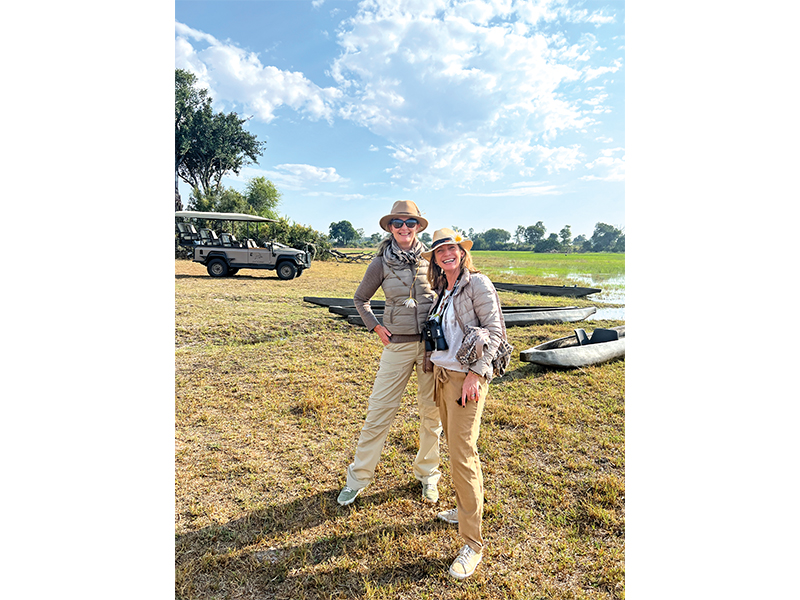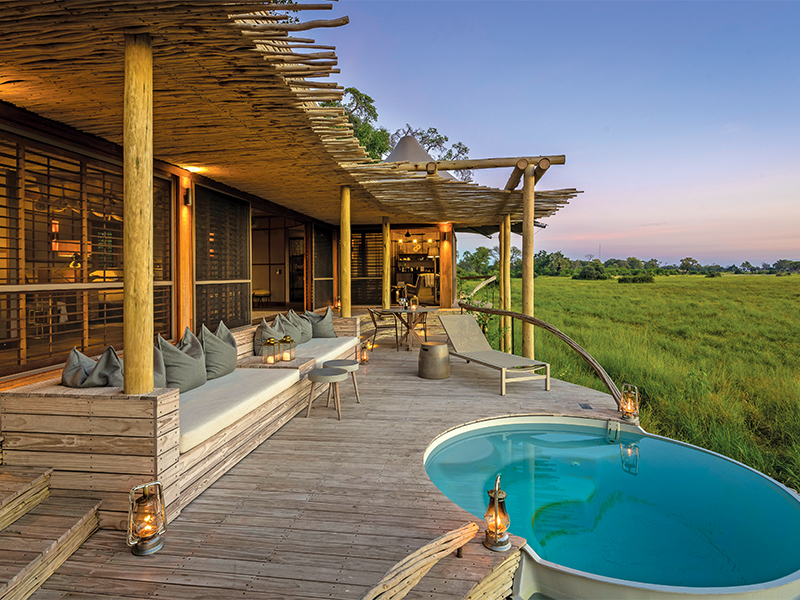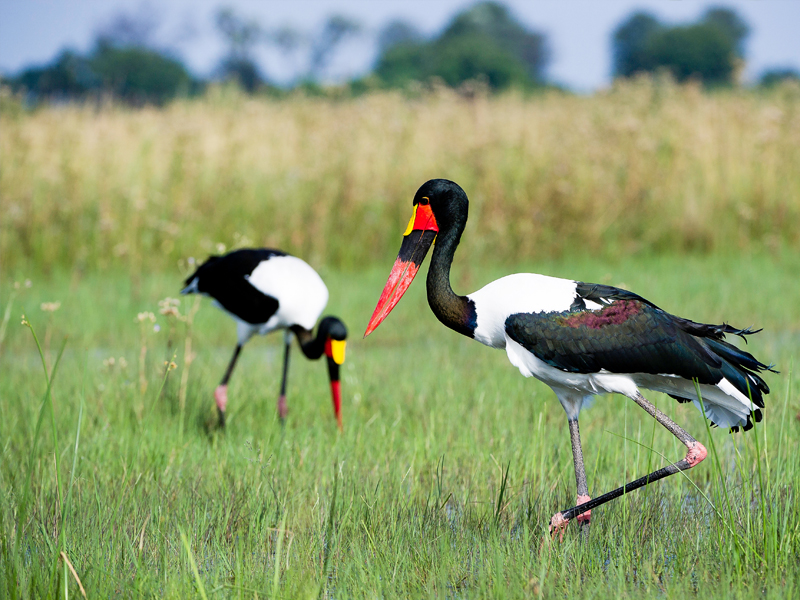If you’re considering booking a safari in the Okavango Delta, Botswana’s amazing nature wonderland, while also staying in comfort and luxury, read on! Expat Living’s LARA SAGE reviews two luxury lodges in the transient watery landscape that are teeming with wildlife – the architectural marvel that is Jao, and decadent Mombo. Here too she suggests three ideal lodges suited to family travel – Xaranna tented camp with all year water activities, and Qorokwe in an area teeming with wildlife.
# Jao
Conservation and hospitality company Wilderness (formerly Wilderness Safari) operates over 60 lodges and camps across eight African countries. Among them, are lodges in Botswana’s famed Okavango.
One of those, Wilderness Jao, opened in 1999 but has more recently had a complete revamp. The results are awe-inspiring! The astounding installation of a giraffe skeleton in the library is one photo-worthy highlight. And the woven iconic bird nest structure at the swimming pool is another. It hovers just above the ebb and flow of delta water that arrives and then recedes again each year.
In fact, the entire lodge is elevated, creating a bird’s eye view of the meandering river below, where wildlife passes through, grazing and drinking. The new sustainable lodge was refurbished using synthetic materials that look like palm fronds for roofing, and with long-lasting supports and fire-retardant thatching. The design allows light into the buildings and panoramic views out. Slender sticks bound together create the awnings and dappled shade, effective in the heat of summer.
The luxury lodge is shaded by ebony trees (known as jackalberry trees), sycamore figs, leadwood and marula trees. Marula fruit is a yellow bulb housing a tart, white pulp that’s popular among wildlife. It’s also used to make a silky local liqueur, Amarula Cream. Fermented and distilled marula fruit is blended with cream and sugar to make a sweet, butterscotch-flavoured drink.
In keeping with the sustainable nature of the makeover at Jao, the original carved rosewood has been used in the library and spa. No material goes to waste! The original balustrade and large wide steps have been incorporated along the elevated walkways to the guest suites.
Magnificently roomy suites
These double-volume suites are huge to say the least – colossal might be a better word! They each include an indoor table with stone slab kitchenette for in-room dining. The ample living room is adorned with mesh and reed-like cords, wall coverings of grass materials, and furnishings adorned with leather straps. The oval shape of the lily pad is echoed in the ottoman, the carpets and the plunge pool. Pendant hanging lights are a striking artistic feature as is the leather hide chandelier that imitates the palm fronds found in the region. The unobstructed façade of the room captures the panoramic landscape beyond.
In the gold and green glow of late afternoon light, I lulled myself into a calm trance while rocking on the swinging circular chair on our private deck. The gentle motion and nature’s background sounds of beetles, birds and soft wind through leaves subdues you and makes you one with the outside world. An oversized bed leads to an open-plan bathroom with oval mirrors mounted on waterlily-shaped vanities and bathtub, and a choice of indoor and outdoor showers. Cool air enters the room through a state-of-the-art cooling system for summer. And there’s a pellet fireplace for nippy nights in winter.
Jao is a place for pensive contemplation and relaxation. It’s best enjoyed with leisurely time to while away the days overlooking the waterways or in the museum-like library filled with books on flora and fauna, and a wall dedicated to light-hearted photos from this historical family camp’s transformation and renovation.
When to visit
Water creeps daily into the Okavango Delta, gradually encroaching on dry plains and filling the flat vista. Around late May or early June, it reaches the area around Jao, transforming this riverside lodge into a watery one. This changes the safari experience from four-wheel driving to boating. All year round, though, you can enjoy gliding along in a mekoro (dugout canoe) that epitomises a trip to Botswana.
# Mombo
Wilderness Mombo is aptly referred to as “the place of plenty”. It captures the wanderlust of the colonial African adventurer, but with a gob-smackingly impressive décor. The latter includes a copper bathtub and room-divider that shines light through grass stencil cuttings onto a lavish suite.
This land camp on the Okavango’s famed Chief’s Island is decadent and indulgent – and the wildlife sightings are remarkable. A luxury safari here offers an exotic option for a milestone celebration, a proposal or a honeymoon; you can enjoy a lantern-lit nature setting for sundowners, a harvest-style Bush breakfast on a river bank, and scrumptious meals in the main restaurant with wine pairings suggested by the in-house sommelier – all this following a taste of the barman’s signature tipple after returning from a game drive!
The lodge
The conical topped tents of Mombo echo the termite mounds of the region. These firm, raised areas of earth become islands when the water rises; birds drop seeds on them and then trees grows on these tiny islands, offering a habitat for all sorts of creatures.
At Mombo, elevated walkways link the guest area to widely spread suites. These boardwalks offer a place of safety, rising up and down sporadically to allow corridors for different animals to pass below.
The décor of this luxury lodge has the quintessential trimmings of a pioneer camp but with cutting-edge modern finishes, private plunge pools, and trendy linen fabric prints and light fittings embellishing the rooms.
An elephant birth!
Our highly qualified guide drove us to some phenomenal wildlife sightings, all the time identifying signals and sounds as clues – from an alarmed bird to the crunch of branches. Once, he followed the unusual trumpeting of an elephant in the distance, leading us to the unforgettable sight of an elephant calf being born. Another elephant – in the role of midwife – stood by the mother, kicking up dust to hide the sight, preventing predators from snatching the newborn after its 22-month gestation. Then, as if telepathically, a nearby feeding herd of seven or so elephants emerged to form a shield of mammoth bodies between our safari vehicle and the birthing elephant.
After half an hour, the baby was gently nudged onto its wobbly legs. Then, to our surprise, a full herd of 30 or more arrived from the thicket, trumpeting in greeting and celebration. The newborn was guided along softly by its mother’s trunk, while it floundered in ungainly fashion. Then, the herd ambled away with the tiny new baby, disappearing into the vegetation silently – as the mighty elephant so inexplicably does, despite its size.
Landscape and wildlife
We were at Mombo soon after a grassland fire had passed through. New shoots could be seen, indicative of nature’s ability to regenerate. The delta is a land of contrasts. As the season grows drier, the water creeps in. When we visited in late May, waters were pooling slowly into sandy roads, offering a feast of snails for open-billed storks.
The land masses soon became life-sustaining mini eco-systems for animals that must cross the water channels as they rise. I hadn’t considered the trepidation of giraffes making this crossing until I watched a herd do so cautiously, with the very real danger of slipping into a deep channel. (A group of giraffes is aptly called a “tower” or a “journey” – they thrive on the acacia trees in this area.) There’s also a healthy warthog and hyena population here and countless predators.
Every safari offers unique and personal experiences. Mine included not just the elephant birth, but a ferocious honey badger running headfirst into a pack of endangered African wild dogs, snarling and lurching with teeth bared! I also saw a sneaky and slender mongoose brazenly stealing meat from under a sleeping lion’s nose, and the reunion of a leopard cub with its mother as she returned from marking her territory (the scent is surprisingly reminiscent of butter popcorn!).
As the Wilderness slogan espouses: “Discover Earth’s Ultimate Untamed Places”. The untamed element here is invigorating, and the word ultimate says everything else!
Travel tip
In the wet season, Jao is surrounded with water but Mombo is not. A great way to experience the delta’s wildlife is to stay in both. First-time safari travellers would be best starting with a landed camp, teeming with wildlife and big game viewing opportunities. Next, move on to the more languid pace of a reflective water camp
For more safari advice, contact Lara.Sage@expatliving.sg, EL’s own Africa Travel specialist
This article on safaris in the Okavango Delta, Botswana, first appeared in Expat Living. You can purchase the latest issue or subscribe so you never miss a copy!
Ecotourism adventure in the Okavango Delta
LARA SAGE and family got to enjoy three camps run by African ecotourism operator Wilderness Safaris. The Okavango Delta in Botswana showed them its best through wildlife, scenery and hospitality.
The unassuming airport of Maun in Botswana is your point of arrival when travelling to the Okavango Delta. When I asked a porter, “How far from Maun to the Delta?” his colloquial response of “Way far close!” amused me. It was a vague yet accurate synopsis of what is a lengthy distance by road, but a short hop by air.
Flying between camps in small planes offers the marvel of seeing this wonder from the air. We’d come in December, a secret season. There’s more availability in camps, fewer people and better rates. But the Delta waters have receded – even if, ironically, the summer rains have begun.

To understand this natural phenomenon, it’s important to know that the water level of the Okavango Delta is determined by rainfall in Angola (a thousand kilometres away), which falls from October to April and flows down two major tributaries into Botswana. By June, this water percolates through the delta system, inundating seasonal floodplains until it gradually subsides. By August, you can see the water levels drop by measurable amounts overnight.
As we attempted to set off in our light aircraft from Maun, torrential rain flooded the runway. Our wheels were submerged, leaving us to wait out the exhilarating storm. When airborne, our pilot deftly manoeuvred between cumulus clouds and literally flew around pockets of rainfall. This cleared the way for us to enjoy the remainder of the flight looking down on a paradise of waterways and wildlife, until we landed on a dirt runway near our camp.

#1 Little Vumbura
At this camp, you’re assured of water activities all year round. Little Vumbura’s six tented suites offer an authentic safari atmosphere on an inland island, reachable only by boat. This is no deterrent for herds of antelope as they come and go. Elephants wade by, too, ambling into camp to strip the bark off trees and eat the foliage.
An African wildlife adventure is intensely personal and intimate. Each safari is unique in what you see, how you feel, and the camps you visit. For many, it goes beyond the dramatic encounters. In the Okavango Delta, you’ll experience a mixture of boating, canoeing (on a traditional mokoro, or dug-out canoe) and open vehicles traversing the dried-up floodplains.
Animal encounters
Our game drives included moving through the type of low water that’s synonymous with images of running herds of red lechwe antelope. On the plains, we saw a coalition of black-maned lions up close. Another sighting involved cheetah cubs balanced on a tall termite mound, making high-pitched vocalisations and contented purrs – all to the background metallic chirp of a blacksmith plover. We also saw countless herons and storks on their stilted legs, and eagles catching thermals with their wide wingspans splayed. You can’t miss the aptly-named sausage tree, too, with its corndog-like hanging fruit, and the bright red fireball lily.
We were often entertained by seeing blubbery-bodied hippos out of water. Sensing they were vulnerable, they would make an ungainly watery dash back to the sanctity of their pools to resume their occasional submerged snorts and flicks of the ear. Don’t be fooled; if one of these mighty beasts opens its gigantic jaws, it could crush you. And therein lies the adrenalin rush of a safari – along with seeing a hyena amble up to sniff at our open vehicle in the moonlight, and hearing lions roar outside our room at night! Happily, all this is in the expert hands of your ranger, so you always feel safe.
Traditional boat ride
To “take or not to take” a mokoro ride on this trip proved to be one of the bigger decisions of my life. I didn’t want to encounter anything too wild while in this traditional boat, even with a standing guide pushing us along with a pole.
My anxiety was unfounded; this tranquil journey through reeds and watery reflections was utterly serene. Among other things, we admired the fingernail-sized snowflake waterlily that opens in the morning and closes in the afternoon – very different to the night lily with its serrated pad. Our guide showed us how they snap the lily stalks to use as straws for drinking water without alerting crocodiles. It’s remarkable how crystal clear the water is, too – you can see to the very bottom. We drifted past aquatic ferns that local villagers use as insect repellent, spotting minuscule reed frogs at eye level. This quiet gliding also allowed us to get close to nesting pygmy geese, kingfishers and an African jacana. With his long-toed feet (adapted for walking on floating mud and lily pads), he seemingly ran on water, flapping excessively to take flight to land just a little further out of reach.
#2 Savuti Camp
There are plenty of Wilderness Safaris camps on offer, either water- or land-based, or a combination of both. Bear in mind that the appeal of each will vary according to the season. As we know, to every season there is a purpose, and we are just onlookers to these cycles.
The two other spots we visited on our Okavango Delta trip included the elevated Savuti Camp. There, our spacious canvas family suite overlooked a verdant green waterway, the Savute Channel. As a result of a subtle shift in underlying tectonic plates, the waters of this channel can intermittently appear or disappear into the ground. Between 1980 and 2008, the Savute stopped flowing entirely, but a ribbon of grassland remained, attracting bountiful wildlife.
It’s once again flowing. In the dry season, animals congregate in abundance at this rich water source, and along its banks, heavy with vegetation. It’s notorious for huge herds of elephants in the dry season; when the rains come, the animals disperse into the thicket. Until you’ve seen it for yourself, you can’t fathom how such enormous creatures can move so silently and seemingly vanish.
The green season brings a great sense of relief as trees and shrubs burst into leaf and young are born. Nursery herds of impala were a delight to watch as they frolicked, jumping joyfully and suckling with their strong tails wagging. And seldom were we without the iconic call of fish eagles.

#3 Qorokwe
Our final destination, Qorokwe, offers modern, stilted units, overlooking a water hole. The main camp is slick with sun loungers and an inviting pool to wallow in during the midday heat. The family suite has the added indulgence of its own plunge pool on a raised deck – it felt like a chic apartment with stylish ethnic finishes in the wilderness, and was the ideal place for us to end our adventures.
As we left, after six days spent in three different camps, the staff waved us off warmly. They had entertained us with traditional singing, dancing and a demonstration in basket weaving; and, from bug jars for youngsters to joking banter with teens, they had artfully engaged and enlightened all ages.
One portion of every bed night spent with Wilderness Safaris goes to conservation; another goes to community upliftment programmes. So, while a journey with the group will change your life, it will also change that of those less fortunate than you. It will give your African journey more purpose, and make a positive impact on educating young people and helping them appreciate and protect their magnificent natural heritage.
Not only that, but a family safari is a superb way to spend quality time together – to reconnect and to disconnect.
Getting there:
You can fly to Maun in Botswana via Cape Town or Johannesburg. The Delta can also be accessed via Livingstone in Zambia, or Victoria Falls in Zimbabwe, if you’d like to include a stop at another natural wonder of the world.
For more safari advice, contact Lara, EL’s Africa travel specialist






















